|
|
|
|
|
|
 |
|
|
 |
 |
 |
| |
Having won the league title in 1983, Gor Mahia hit the
year 1984 in full stride. Yet their was a little bit of bad news.
Charles Otieno the midfield stalwart who had been called 'the engine' of
the team by coach Len Julians was poached by Kenya Breweries much to the
chagrin and depression of Gor Mahia fans who hounded Otieno every day in
his neighbourhood. But the arrival of Abass Khamis Magongo from the
Tanzanian league lifted the fans spirits. From the moment he arrived, it
was obvious that he had something special.
They started the season with the annual CECAFA cup which was held in
Kenya. Gor Mahia were in group A in Nairobi while arch rivals AFC
Leopards were in group B in Mombasa. It was the first major
international club tournament held at the newly constructed Nyayo
Stadium. Prior to that, Gor Mahia had been training in Nyahururu much to
the delight of locals who turned out in droves to watch them train. |
|
|
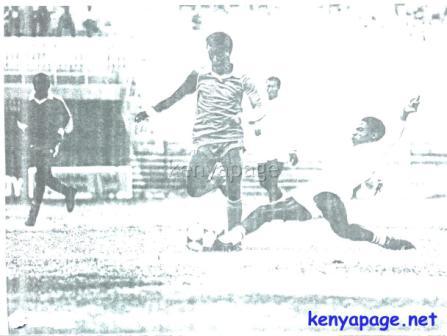 |
Abbas Khamis Magongo, who joined from an obscure Tanzanian team, became the heart and soul of the club and was rewarded with several nicknames such as Zamalek, Orieko(genious) and Santana.
|
| |
In the second round they faced Zamalek of Egypt. The first leg was
played in Cairo Egypt. The Egyptians had expected to run up the score on
Gor Mahia but this was not to be. 40 minutes into the match the match
was still scoreless much to the chagrin of the 100,000 Egyptian fans who
had crammed the Nasser stadium to cheer on their team. Then came the
defining moment: Abbas Magongo attempted to tackle an Egyptian player a
few yards outside the penalty box. The player took a tumble and rolled
into the penalty box. The match referee who was from Sudan inexplicably
awarded Zamalek a penalty kick. After Zamalek scored the penalty, the
referee then proceeded to inexplicably give Abbas Magongo his marching
orders. Gor Mahia players who were already enraged at the referee for
making several dubious calls against confronted the referee. Len Julians
and Abdallah Shebe ran onto the field to restrain the players. The
referee was now surrounded by Zamalek players. Moments later he suddenly
claimed to have broken his arm in the melee. The referee then called off
the match. Gor Mahia were disqualified from the tournament and suspended
for 2 years. Additionally , 6 players : Abbey Nassur , Otieno Solo ,
Abbas Magongo , Onyango fundi , Peter Otieno 'Bassanga' and Abdallah
Shebe, were banned from international soccer for 2 years along with
coach Julians. The referee along with CAF had clearly been compromised
by Zamalek.
Despite this massive setback, Coach Len Julians re-grouped his troops
and the club won their second successive league title. It did not come
without controversy as some clubs wanted the players who had been banned
by CAF in the "Zamalek affair" to be also banned from the local league.
In June 1984, Gor Mahia faced AFC Leopards in a match which will be
remembered for what happened off the field as well as what happened on
it. Prior to the match, AFC fans piled up some straw hats which were
popular with Gor Mahia fans and set them on fire. Gor Mahia fans
retaliated with a hail of stones. Leopards won the match 1-0. Gor Mahia
fans started to believe that Nyayo stadium was somehow bewitched to
favor AFC. Still Kogalo remained atop the league standings. On the
second to last game of the league, Gor Mahia beat Lake Warriors 2-0 to
secure the title. Coach Len Julians was carried shoulder high by fans at
the end of the match, not only for helping secure the league but also
for introducing a brand of exciting football the likes of which locals
had never seen. |
|
|
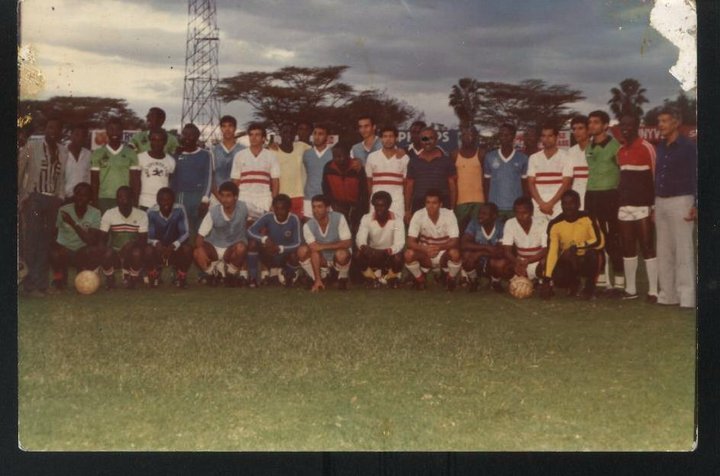 |
In 1985, Zamalek visited Nairobi and held a joint training session with Gor Mahia as a gesture of friendship. Zamalek later admistted that Gor Mahia were the toughest team they faced in Cairo
|
| |
In February of 1984, Gor Mahia had played a friendly
against Schaffhausen, a team which at the time played in the Swiss top
division. The match ended 1-1. Hezborn Omollo scored the match opener
but the Swiss side equalized via a penalty. Striker Abdallah Shebe
impressed the Schaffhausen enough to earn a trial which he passed. Shebe
played in Switzerland for 2 years.
In 1985 despite the continental ban , Gor Mahia were able to participate
in the CECAFA cup held in Sudan. With 6 of their best players banned,
and without there coach, they were not expected to make the semi-finals
let alone win the trophy. Club fans had little hope. The media gave them
no chance. A ridculous cartoon in the standard newspapers by Kirui
Koskei portrayed hopeless Gor Mahia players returning home in a soda
crate after having lost in Sidan.
However Former club player Maurice Ochieng stepped in as interim head
coach. With several new faces in the team such as George Nyangi "artllery"
, William Obwaka and Swaleh Ochieng Oswayo . These teamed up with the
remaining veterans to launch the CECAFA cup campaign.
|
|
|
| |
In February of 1984, Gor Mahia had played a friendly against Schaffhausen, a team which at the time played in the Swiss top division. The match ended 1-1. Hezborn Omollo scored the match opener but the Swiss side equalized via a penalty. Striker Abdallah Shebe impressed the Schaffhausen enough to earn a trial which he passed. Shebe played in Switzerland for 2 years.
In 1985 despite the continental ban , Gor Mahia were able to participate in the CECAFA cup held in Sudan. With 6 of their best players banned, and without there coach, they were not expected to make the semi-finals let alone win the trophy. Club fans had little hope. The media gave them no chance. A ridculous cartoon in the standard newspapers by Kirui Koskei portrayed hopeless Gor Mahia players returning home in a soda crate after having lost in Sidan.
However Former club player Maurice Ochieng stepped in as interim head coach. With several new faces in the team such as George Nyangi "artllery" , William Obwaka and Swaleh Ochieng Oswayo . These teamed up with the remaining veterans to launch the CECAFA cup campaign.
|
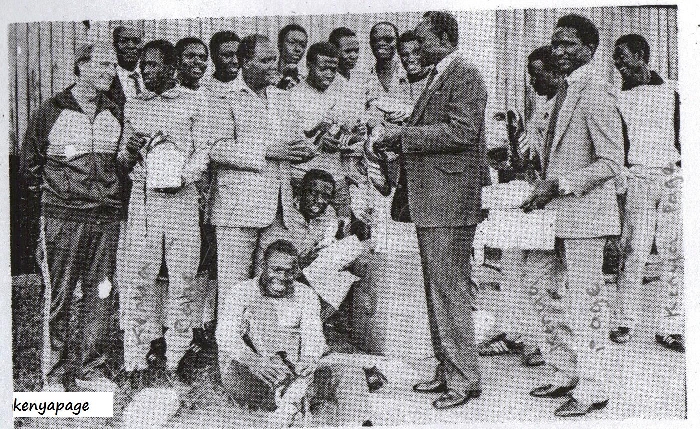 |
Before leaving for the CECAFA cup , Kogalo players received boots from Re Union Chairman Wycliff Rading Omolo (3rd from left. Others in the pic are from left coach Len Julians, talking to Hezborn Omollo, sitting is Tirus Omondi, crouching is Austin "Makamu" Oduor, next to Rading is William Obwaka flanked by Chairman Zack Mbori, Manager Amos Nandi in a sharp suit and keeper David Ochieng joking
|
| |
Gor Mahia started with identical 1-1 draws with Simba or Tanzania and Villa of Uganda before beating Limbe Leaf of Malawi 3-0 and hosts Al Hilal of Sudan 3-1. In the semis Kogalo beat second hosts El Merreikh 2-1. In the final, Gor Mahia yet again met arch rivals AFC Leopards, for the 3rd time in 5 years, a fact which underlined the dominance of Kenyan teams in CECAFA.
Kogalo managed to pull off a spectacular coup in making the final and beating compatriots AFC Leopards 2-0 to lift the cup. William Obwaka, a new signing and a younger brother of club regular Enock Obwaka scored twice in the 35th and 89th minutes. This remains one of the biggest success stories of the club: KHARTOUM 1985. The went on to lift the national league cup later that year.
Emotional Gor Mahia fans poured into the streets of Nairobi to celebrate all night long. When the team returned, there were wild scenes of celebration at the Jomo Kenyatta International airport. There were several factors that caused the emotional celebrations. Gor Mahia had not beaten AFC in more than a year. Gor Mahia last won the CECAFA cup in 1981 and no one had given them a chance to win this time due to the suspension of 6 key players
|
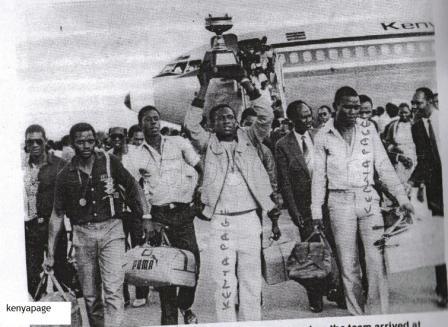 |
Kogalo arrive back at JKI Airport after winning the 1985 CECAFA cup: From left David Ochieng (in shades, Swaleh Ochieng Oswayo, Austin Oduor (in shades), ??, Hezborn Omollo (holding trophy and Tirus Omondi
|
| |
Gor Mahia started the league with aplomb beating Kenya Breweries (now Tusker) 4-2. New signing George Odembo Nyangi who had joined the club straight from Musingu high school, gave fans a sign of things to come when he scored with a breathtaking long range effort. He was soon after nicknamed 'Artillery' by club fans. William Obwaka yet again delighted fans when he scored from a direct free kick. Another new signing Ben Oloo scored the 3rd goal and Sammy Onyango 'Jogoo" sealed the score.
In Mid 1985, Bayer Leverkusen toured the country and played Gor Mahia to a 0-0 draw. In fact Gor Mahia were unlucky not to win as they pinned the Germans in their area for long periods. On Madaraka day, it was time again for the two arch rivals Ingwe and Kogalo to meet at Nyayo. President Moi attended along with almost the entire cabinet. Francis Kadenge opened the scoring in the 25th minute but man of the match, Abass Magongo scored a double to sink AFC 2-1. Gor Mahia clinched the 1985 league when arch rivals AFC Leopards went down 0-3 to Kenya Breweries. Kogalo fans broke out in song and dance when KBL striker Paul Onyiera scored the 3rd goal.
|
 |
Fullback, Swaleh Ochieng Oswayo (left) who joined the club in 1985 often instilled fear into the minds of opposing attackers.
|
| |
At the end of 1985, Zack Mbori was re-elected club Chairman. James Oyugi as secretary general while Syslvester Inda and Abdallah Bekha retained their positions as deputy secretary and Treasurer respectively.
In 1986 , the season started yet again with the CECAFA club cup this time held in Tanzania. The 1st match was against El Merreikh in Mwanza. The Sudanese took the lead via a freekick from Atif Fadel Mula who caught Tirus Omondi in the Gor Mahia goal off guard. A late equalizer from Abass Magongo saved Kogalo from defeat as the match ended 1-1. However the clubs hopes were jolted with identical 0-1 defeats to Maji Maji of Tanzania and Mufulira Wanderers of Zambia, two matches that Gor Mahia dominated but could not score. Having been eliminated, they played Wagad of Somalia in the last group match and won 3-0. The tourney was won by El Merreikh, marking the 1st time a non Kenyan club had won since 1979. Kenyan teams had won the cup an incredible 7 times in a row and met in the final 3 times. Such was the dominance of Kenyan teams in those days.
The blunt forward line that plagued the club in the CECAFA cup returned to haunt them in the national league. Hezborn Omollo who had been the club's leading scorer for the past 3 years, scoring well over 60 goals was taking a break from football to recover from heart problems. And when he did return, he was not as sharp as he once was. Kogalo still had a stellar midfield with George Onyango Fundi, Abass Magongo, John Okello 'Zangi', George Odembo Nyangi and a solid defence manned by John Bobby Ogolla, Austin Oduor, George Otieno 'Solo' who by now had played for the club for an incredible 11 years ! and Peter Otieno Bassanga. However the forwardline could not deliver as it had in the previous year. Gor Mahia finished second in the league to AFC Leopards with many of their matches ending in draws.
|
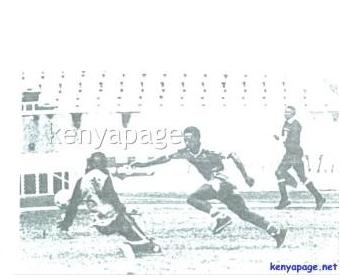 |
Prolific goal scorer Hezborn Omollo in action against Schaffhausen of Switzerland
|
| |
Perhaps the most memorable match of 1986 came when
Kogalo played Ingwe in front of a packed Nyayo stadium. A double from
Sammy Onyango 'Jogoo' gave Kogalo a 2-0 half time lead. Kogalo fans
could not contain their joy as they sung melodiously throughout half
time. However a series of inexplicable events happened in the second
half and suddenly AFC were up 3-2. The last goal scored by Patrick Shim
was literally assisted by Tirus Omondi in the Gor Mahia goal. Days later
it emerged that wealthy AFC chairman had bribed Gor Mahia players to
throw the match. Tirus Omondi, Zangi, Magongo, weres suspended. Magongo
was given a reprieve when he came clean. At the end of the match, Sammy
Onyango was seen sobbing uncontrollably. A section of superstitious fans
said that whenever he scored against AFC, no one else could score.
Howver on this day, Sammy Onyango had played his heart out only to see
victory stolen.
Gor Mahia saved face by winning the inaugural Moi golden cup by beating
Bandari 1-0 in the final. An injury time goal by Hezborn Omollo secured
the victory at Nyayo stadium. The tough Bandari outfit coached by
Mohammed Kheri was at the time playing in the Coast provincial league.
Winning the Moi golden cup enabled Gor Mahia to participate in the 1987
Africa Cup winners cup. |
|
|
|
|
 |
 |
 |
|
|
|
 |
|
|
|
|
|
 |
|
|
|
|
|
 |
 © Copyright 1999-2009, Parallels. All Rights Reserved.
© Copyright 1999-2009, Parallels. All Rights Reserved.
|
 |
 |
|
|